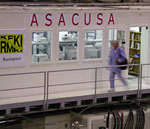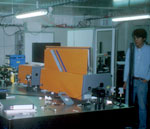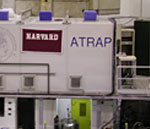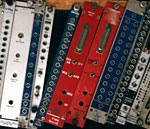
After the particles leave the accelerator, the researchers are in charge. When particles reach the experimental areas, scientists manipulate them according to the needs of their experiments. In most cases, there’s a number of hoops to jump through. For example, before being able to conduct experiments, researchers on ATRAP need to trap large numbers of antiprotons, combine them with positrons, and systematically create antihydrogen atoms that exist long enough to be studied.
Here’s a description of what’s taking place in three of the AD’s experimental areas.
 The front of ASACUSA's trailer.
The front of ASACUSA's trailer.
|
ASACUSA
If it’s spelled with a "k," Asakusa is the name of one of the older quarters of Tokyo. Tokyo University, which is not far from Asakusa, has been involved with research at CERN since 1991.
Spelled with a "c," ASACUSA stands for Atomic Spectroscopy and Collisions Using Antiprotons. In this experiment, scientists create "atomcules" of helium. Usually, helium has a nucleus with a positive charge of +2. The nucleus is orbited by 2 electrons, each with a charge of -1. In the ASACUSA experiment, a beam of antiprotons is directed from the AD into a thimble full of helium chilled to -271 K (very close to absolute zero). The antiprotons readily replace one of the electrons, and the "atomcule" is stable for a millisecond -- a positively long period in particle physics terms.
 Inside ASACUSA's laser hut.
Inside ASACUSA's laser hut.
|
Once the "atomcules" are made, ASACUSA scientists shoot laser beams into the helium. They tune the laser beams to just the right color, and the anti-protons make a quantum jump, emitting a photon. The frequency of that photon will tell researchers about the photon that stimulated the emission. Researchers will compare this frequency with what is predicted by a theory about atomcules. Through this technique, ASACUSA scientists are trying to determine whether there is a mirror image symmetry between matter and antimatter.
 ATRAP's trailer, showing the experiment's affiliation with Harvard.
ATRAP's trailer, showing the experiment's affiliation with Harvard.
|
ATHENA
and
ATRAP
These two experiments are very similar: they seek to directly compare the properties of hydrogen and antihydrogen. Even a tiny difference in the energy spectrum of the two could mean a rethinking of the current understanding of the principles of physics.
 A warning on the laser hut door to be aware of radiation.
A warning on the laser hut door to be aware of radiation.
|
The first step is to create antihydrogen by combining antiprotons with positrons. Antiprotons enter the experimental areas from the AD, and are slowed down even more with thin degrader coils. They then go into a special apparatus called a Penning-Malmberg trap. The trap is a brass cylinder, small enough to fit on a scientist’s desk, with several cylindrical electrodes inside. The trap is put in a magnetic field. Inside, charged particles are contained using the magnetic field and the electric field generated by the electrodes. Researchers then inject a cloud of cooled electrons into the chamber. When this system reaches equilibrium -- the electrons warming and the antiprotons cooling -- the temperature is about 4 K.
Positrons from radioactive sodium are brought into a chamber in the trap adjacent to the trap holding the antiprotons. Then, a small opening appears between the two, and they are allowed to mix. There are several techniques for encouraging antihydrogen formation, and researchers are experimenting with which ones are more effective. They expect to be able to create between 10 and 100 atoms per second.
 The back ends of electronic consoles are lined up like books on the shelves in an experimental area.
The back ends of electronic consoles are lined up like books on the shelves in an experimental area.
|
Once the atoms are formed, they drift toward the electrodes nearby, and annihilate. This interaction emits energy that is characteristic of the formation of certain particles. By looking at the patterns of annihilation, scientists will verify that they have produced antihydrogen.
A second phase of the ATHENA experiment will entail storing antihydrogen atoms in a magnetic bottle. Laser beams will be directed at them, in an effort to learn whether light of the same wavelength will excite both hydrogen and antihydrogen atoms.